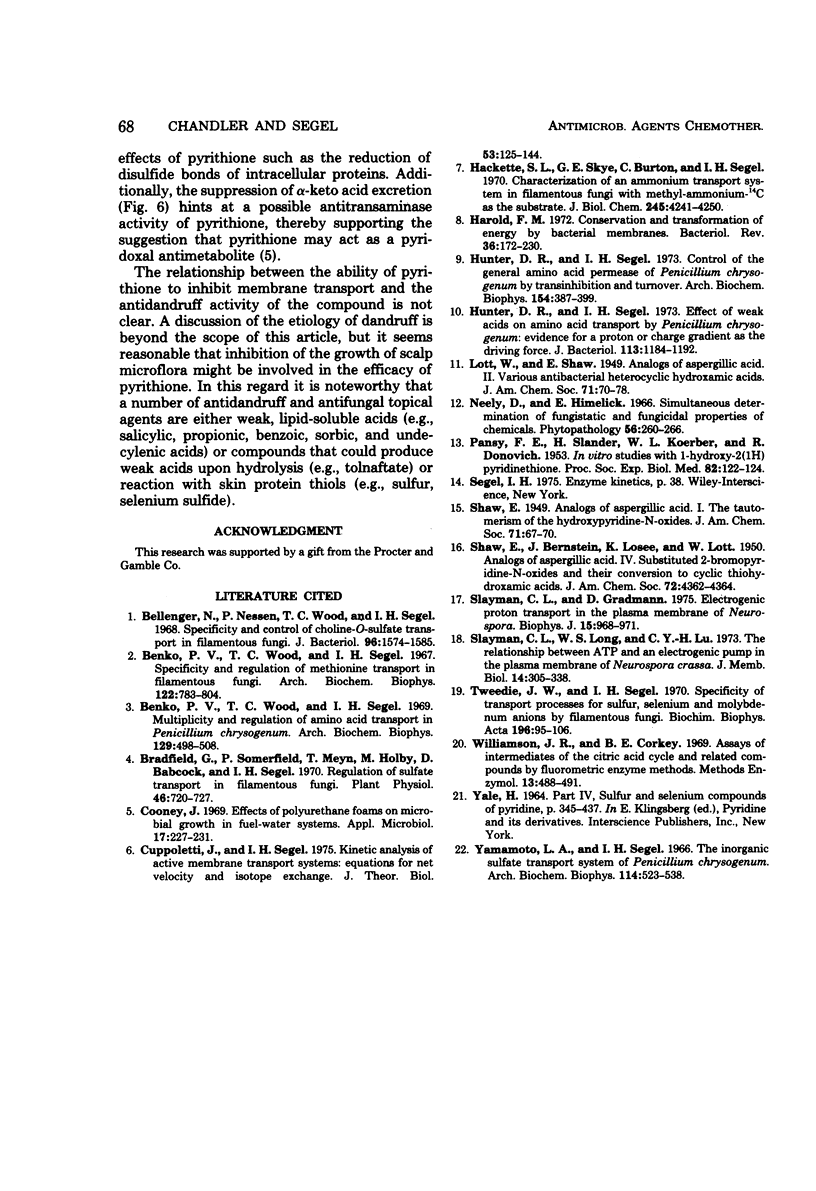Abstract
Pyrithione is a general inhibitor of membrane transport processes in fungi. A brief preincubation of Penicillium mycelia with pyrithione resulted in a marked decrease in the activities of a variety of independently regulated transport systems, including those for inorganic sulfate, inorganic phosphate, methylamine (actually, the NH4+ permease), choline-O-sulfate, glucose, l-methionine (a specific system), and several hydrophobic l-α-amino acids (the general amino acid permease). The degree of inhibition at any fixed pyrithione concentration and exposure time increased as the pH of the incubation medium was decreased. This result strongly suggests that the active species is the un-ionized molecule and that pyrithione acts by collapsing a transmembrane ΔpH driving force. The degree of transport inhibition caused by a given concentration of pyrithione increased with increasing time of exposure to the inhibitor. However, exposure time and pyrithione concentration were not reciprocally related. At “low” pyrithione concentrations, transport inhibition plateaued at some finite value. This observation suggests that the fungi can detoxify low levels of the inhibitor. The concentration of pyrithione required for a given degree of growth inhibition increased as the experimental mycelial density increased. This phenomenon was consistent with the suggestion that the fungi are capable of inactivating pyrithione.
Full text
PDF








Selected References
These references are in PubMed. This may not be the complete list of references from this article.
- Bellenger N., Nissen P., Wood T. C., Segel I. H. Specificity and control of choline-O-sulfate transport in filamentous fungi. J Bacteriol. 1968 Nov;96(5):1574–1585. doi: 10.1128/jb.96.5.1574-1585.1968. [DOI] [PMC free article] [PubMed] [Google Scholar]
- Benko P. V., Wood T. C., Segel I. H. Multiplicity and regulation of amino acid transport in Penicillium chrysogenum. Arch Biochem Biophys. 1969 Feb;129(2):498–508. doi: 10.1016/0003-9861(69)90207-0. [DOI] [PubMed] [Google Scholar]
- Bradfield G., Somerfield P., Meyn T., Holby M., Babcock D., Bradley D., Segel I. H. Regulation of sulfate transport in filamentous fungi. Plant Physiol. 1970 Nov;46(5):720–727. doi: 10.1104/pp.46.5.720. [DOI] [PMC free article] [PubMed] [Google Scholar]
- Cooney J. J. Effects of polyurethane foams on microbial growth in fuel-water systems. Appl Microbiol. 1969 Feb;17(2):227–231. doi: 10.1128/am.17.2.227-231.1969. [DOI] [PMC free article] [PubMed] [Google Scholar]
- Cuppoletti J., Segel I. H. Kinetic analysis of active membrane transport systems: equations for net velocity and isotope exchange. J Theor Biol. 1975 Sep;53(1):125–144. doi: 10.1016/0022-5193(75)90107-1. [DOI] [PubMed] [Google Scholar]
- Hackette S. L., Skye G. E., Burton C., Segel I. H. Characterization of an ammonium transport system in filamentous fungi with methylammonium-14C as the substrate. J Biol Chem. 1970 Sep 10;245(17):4241–4250. [PubMed] [Google Scholar]
- Harold F. M. Conservation and transformation of energy by bacterial membranes. Bacteriol Rev. 1972 Jun;36(2):172–230. doi: 10.1128/br.36.2.172-230.1972. [DOI] [PMC free article] [PubMed] [Google Scholar]
- Hunter D. R., Segel I. H. Control of the general amino acid permease of Penicillium chrysogenum by transinhibition and turnover. Arch Biochem Biophys. 1973 Jan;154(1):387–399. doi: 10.1016/0003-9861(73)90071-4. [DOI] [PubMed] [Google Scholar]
- Hunter D. R., Segel I. H. Effect of weak acids on amino acid transport by Penicillium chrysogenum: evidence for a proton or charge gradient as the driving force. J Bacteriol. 1973 Mar;113(3):1184–1192. doi: 10.1128/jb.113.3.1184-1192.1973. [DOI] [PMC free article] [PubMed] [Google Scholar]
- PANSY F. E., STANDER H., KOERBER W. L., DONOVICK R. In vitro studies with 1-hydroxy-2(1H) pyridinethione. Proc Soc Exp Biol Med. 1953 Jan;82(1):122–124. doi: 10.3181/00379727-82-20041. [DOI] [PubMed] [Google Scholar]
- Slayman C. L., Gradmann D. Electrogenic proton transport in the plasma membrane of Neurospora. Biophys J. 1975 Sep;15(9):968–971. doi: 10.1016/S0006-3495(75)85877-2. [DOI] [PMC free article] [PubMed] [Google Scholar]
- Slayman C. L., Long W. S., Lu C. Y. The relationship between ATP and an electrogenic pump in the plasma membrane of Neurospora crassa. J Membr Biol. 1973;14(4):305–338. doi: 10.1007/BF01868083. [DOI] [PubMed] [Google Scholar]
- Tweedie J. W., Segel I. H. Specificity of transport processes for sulfur, selenium, and molybdenum anions by filamentous fungi. Biochim Biophys Acta. 1970 Jan 6;196(1):95–106. doi: 10.1016/0005-2736(70)90170-7. [DOI] [PubMed] [Google Scholar]
- Yamamoto L. A., Segel I. H. The inorganic sulfate transport system of Penicillium chrysogenum. Arch Biochem Biophys. 1966 Jun;114(3):523–538. doi: 10.1016/0003-9861(66)90376-6. [DOI] [PubMed] [Google Scholar]


